Battle of Manzikert
The Battle of Manzikert was fought between the Byzantine Empire and the Seljuk Empire on 26 August 1071 near Manzikert, theme of Iberia (modern Malazgirt in Muş Province, Turkey). The decisive defeat of the Byzantine army and the capture of the Emperor Romanos IV Diogenes[9] played an important role in undermining Byzantine authority in Anatolia and Armenia,[10] and allowed for the gradual Turkification of Anatolia. Many of the Turks, who had been travelling westward during the 11th century, saw the victory at Manzikert as an entrance to Asia Minor.[11]
| Battle of Manzikert | |||||||
|---|---|---|---|---|---|---|---|
| Part of the Byzantine–Seljuq wars | |||||||
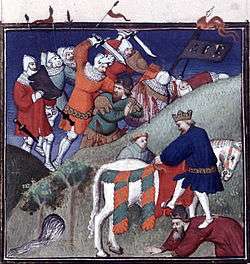 In this 15th-century French miniature depicting the Battle of Manzikert, the combatants are clad in contemporary Western European armour. | |||||||
| |||||||
| Belligerents | |||||||
| Commanders and leaders | |||||||
|
Romanos IV (POW) Nikephoros Bryennios Theodore Alyates Andronikos Doukas |
Alp Arslan Afshin Bey Artuk Bey Kutalmışoğlu Suleyman | ||||||
| Strength | |||||||
|
40,000[5] (close to half deserted before battle. Turkic mercenaries defected to the Seljuk side) | 20,000-30,000[6][7] | ||||||
| Casualties and losses | |||||||
|
2,000[8]-8,000 killed[6] 4,000 captured[8] 20,000 deserted[5] | unknown | ||||||
The brunt of the battle was borne by the professional soldiers from the eastern and western tagmata, as large numbers of mercenaries and Anatolian levies fled early and survived the battle.[12] The fallout from Manzikert was disastrous for the Byzantines, resulting in civil conflicts and an economic crisis that severely weakened the Byzantine Empire's ability to adequately defend its borders.[13] This led to the mass movement of Turks into central Anatolia—by 1080, an area of 78,000 square kilometres (30,000 sq mi) had been gained by the Seljuk Turks. It took three decades of internal strife before Alexius I (1081 to 1118) restored stability to Byzantium. Historian Thomas Asbridge says: "In 1071, the Seljuqs crushed an imperial army at the Battle of Manzikert (in eastern Asia Minor), and though historians no longer consider this to have been an utterly cataclysmic reversal for the Greeks, it still was a stinging setback."[14] It was the first, and only, time in history a Byzantine emperor had become the prisoner of a Muslim commander.
Background
Although the Byzantine Empire had remained strong and powerful in the Middle Ages,[15] it began to decline under the reign of the militarily incompetent Constantine IX Monomachos and again under Constantine X Doukas—a brief two-year period of reform under Isaac I Komnenos merely delayed the decay of the Byzantine army.[16]
About 1053 Constantine IX disbanded what the 11th century Greek historian John Skylitzes calls the "Iberian Army", which consisted of 50,000 men. Skylitzes' contemporaries, the former officials Michael Attaleiates and Kekaumenos, agree that by demobilizing these soldiers Constantine did catastrophic harm to the Empire's eastern defenses. Constantine made a truce with the Seljuks that lasted until 1064, but a large Seljuk army under Alp Arslan attacked the theme of Iberia and took Ani; after a siege of 25 days, they captured the city and slaughtered its population.[17]
In 1068 Romanos IV Diogenes took power, and after some speedy military reforms entrusted Manuel Komnenos (nephew of Isaac I Komnenos) to lead an expedition against the Seljuks. Manuel captured Hierapolis Bambyce in Syria, next thwarted a Turkish attack against Iconium with a counter-attack,[9] but was then defeated and captured by the Seljuks under the sultan Alp Arslan. Despite his success Alp Arslan was quick to seek a peace treaty with the Byzantines, signed in 1069; he saw the Fatimids in Egypt as his main enemy and had no desire to be diverted by unnecessary hostilities.[6]
In February 1071, Romanos sent envoys to Alp Arslan to renew the 1069 treaty, and keen to secure his northern flank against attack, Alp Arslan happily agreed.[6] Abandoning the siege of Edessa, he immediately led his army to attack Fatimid-held Aleppo. However, the peace treaty had been a deliberate distraction: Romanos now led a large army into Armenia to recover the lost fortresses before the Seljuks had time to respond.[6]
Prelude
Accompanying Romanos was Andronicus Ducas, son of his rival, John Ducas. The army consisted of about 5,000 professional Byzantine troops from the western provinces and probably about the same number from the eastern provinces. This included 500 Frankish and Norman mercenaries under Roussel de Bailleul, some Turkic (Uz and Pecheneg) and Bulgarian mercenaries, infantry under the duke of Antioch, a contingent of Georgian and Armenian troops and some (but not all) of the Varangian Guard to total around 40,000 men.[18] The quantity of the provincial troops had declined in the years prior to Romanos, as the government diverted funding to mercenaries who were judged less likely to be involved in politics and could be disbanded after use to save money.
The march across Asia Minor was long and difficult and Romanos did not endear himself to his troops by bringing a luxurious baggage train along with him. The local population also suffered some plundering by his Frankish mercenaries, whom he was obliged to dismiss. The expedition rested at Sebasteia on the river Halys, reaching Theodosiopolis in June 1071. There, some of his generals suggested continuing the march into Seljuk territory and catching Alp Arslan before he was ready. Others, including Nicephorus Bryennius, suggested they wait and fortify their position. It was decided to continue the march.[19]
Thinking that Alp Arslan was either further away or not coming at all, Romanos marched towards Lake Van, expecting to retake Manzikert rather quickly and the nearby fortress of Khliat if possible. Alp Arslan was already in the area, however, with allies and 30,000 cavalry from Aleppo and Mosul. Alp Arslan's scouts knew exactly where Romanos was, while Romanos was completely unaware of his opponent's movements.[20]
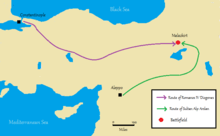
Romanos ordered his general Joseph Tarchaniotes to take some of the regular troops and the Varangians and accompany the Pechenegs and Franks to Khliat, while Romanos and the rest of the army marched to Manzikert. This split the forces into halves of about 20,000 men each. It is unknown what happened to the army sent off with Tarchaniotes — according to Islamic sources, Alp Arslan smashed this army, yet Roman sources make no mention of any such encounter and Attaliates suggests that Tarchaniotes fled at the sight of the Seljuk Sultan — an unlikely event considering the reputation of the Roman general. Either way, Romanos' army was reduced to less than half his planned 40,000 men.[18]
Battle
Alp Arslan summoned his army and delivered a speech by appearing in a white robe similar to an Islamic funeral shroud in the morning of the battle.[21] This was an encouraging message that he was ready to die in battle. Romanos was unaware of the loss of Tarchaneiotes and continued to Manzikert, which he easily captured on 23 August; the Seljuks responded with heavy incursions of bowmen.[22] The next day, some foraging parties under Bryennios discovered the Seljuk army and were forced to retreat back to Manzikert. Romanos sent the Armenian general Basilakes and some cavalry, as Romanos did not believe this was Alp Arslan's full army. The cavalry was destroyed and Basilakes taken prisoner. Romanos drew up his troops into formation and sent the left wing out under Bryennios, who was almost surrounded by the quickly approaching Turks and was forced to retreat once more. The Seljuk forces hid among the nearby hills for the night, making it nearly impossible for Romanos to counterattack.[9][23]
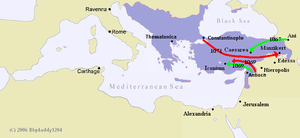
On 25 August, some of Romanos' Turkic mercenaries came into contact with their Seljuk kin and deserted. Romanos then rejected a Seljuk peace embassy. He wanted to settle the eastern question and the persistent Turkic incursions and settlements with a decisive military victory, and he understood that raising another army would be both difficult and expensive. The Emperor attempted to recall Tarchaneiotes, who was no longer in the area. There were no engagements that day, but on 26 August the Byzantine army gathered itself into a proper battle formation and began to march on the Turkish positions, with the left wing under Bryennios, the right wing under Theodore Alyates, and the centre under the emperor. At that moment, a Turkish soldier said to Alp Arslan, "My Sultan, the enemy army is approaching", and Alp Arslan is said to have replied, "Then we are also approaching them". Andronikos Doukas led the reserve forces in the rear—a foolish mistake, considering the loyalties of the Doukids. The Seljuks were organized into a crescent formation about four kilometres away.[24] Seljuk archers attacked the Byzantines as they drew closer; the centre of their crescent continually moved backwards while the wings moved to surround the Byzantine troops.
The Byzantines held off the arrow attacks and captured Alp Arslan's camp by the end of the afternoon. However, the right and left wings, where the arrows did most of their damage, almost broke up when individual units tried to force the Seljuks into a pitched battle; the Seljuk cavalry simply disengaged when challenged, the classic hit and run tactics of steppe warriors. With the Seljuks avoiding battle, Romanos was forced to order a withdrawal by the time night fell. However, the right wing misunderstood the order, and Doukas, as a rival of Romanos, deliberately ignored the emperor and marched back to the camp outside Manzikert, rather than covering the emperor's retreat. With the Byzantines thoroughly confused, the Seljuks seized the opportunity and attacked.[9] The Byzantine right wing was almost immediately routed, thinking they were betrayed either by the Armenians or the army's Turkish auxiliaries. Some authors suppose that Armenians were the first to flee and they all managed to get away, while by contrast the Turkish auxiliaries remained loyal to the end.[25] Other sources suggest that Armenian infantry were stoutly resisting and not turning tail and did not abandon the emperor as many had. When Romanos saw the boldness of the Armenian foot soldiers, he displayed great affection for them and promised them unheard of rewards. In the end, the emperor's personal troops and these Armenian foot soldiers suffered the heaviest casualties in the Byzantine army.[26] The left wing under Bryennios held out a little longer but was also soon routed.[12] The remnants of the Byzantine centre, including the Emperor and the Varangian Guard, were encircled by the Seljuks. Romanos was injured and taken prisoner by the Seljuks. The survivors were the many who fled the field and were pursued throughout the night, but not beyond that; by dawn, the professional core of the Byzantine army had been destroyed whilst many of the peasant troops and levies who had been under the command of Andronikus had fled.[12]
Captivity of Romanos Diogenes
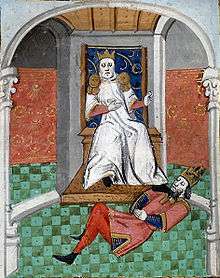
When Emperor Romanos IV was conducted into the presence of Alp Arslan, the Sultan refused to believe that the bloodied and tattered man covered in dirt was the mighty Emperor of the Romans. After discovering his identity, Alp Arslan placed his boot on the Emperor's neck and forced him to kiss the ground.[12] A famous conversation is also reported to have taken place:[27]
- Alp Arslan: "What would you do if I were brought before you as a prisoner?"
- Romanos: "Perhaps I'd kill you, or exhibit you in the streets of Constantinople."
- Alp Arslan: "My punishment is far heavier. I forgive you, and set you free."
Alp Arslan treated Romanos with considerable kindness and again offered the terms of peace that he had offered prior to the battle.[28]
According to Ibn al-Adim, in the presence of Arslan, Romanos blamed the raids of Rashid al-Dawla Mahmud into Byzantine territory for his interventions in Muslim territories which eventually led to the Battle of Manzikert.[29] Romanos remained a captive of the Sultan for a week. During this time, the Sultan allowed Romanos to eat at his table whilst concessions were agreed upon: Antioch, Edessa, Hierapolis, and Manzikert were to be surrendered.[13] This would have left the vital core of Anatolia untouched. A payment of 10 million gold pieces demanded by the Sultan as a ransom for Romanos was deemed as too high by the latter, so the Sultan reduced its short-term expense by asking for 1.5 million gold pieces as an initial payment instead, followed by an annual sum of 360,000 gold pieces.[13] Plus, a marriage alliance was prepared between Alp Arslan's son and Romanos’ daughter.[6] The Sultan then gave Romanos many presents and an escort of two emirs and one hundred Mamluks on his route to Constantinople.
Shortly after his return to his subjects, Romanos found his rule in serious trouble. Despite attempts to raise loyal troops, he was defeated three times in battle against the Doukas family and was deposed, blinded, and exiled to the island of Proti. He died soon after as a result of an infection caused by an injury during his brutal blinding. Romanos' final foray into the Anatolian heartland, which he had worked so hard to defend, was a public humiliation.[13]
Aftermath
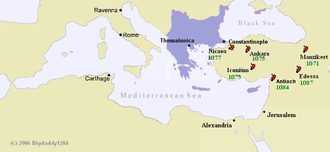
While Manzikert was a long-term strategic catastrophe for Byzantium, it was by no means the massacre that historians earlier presumed. Modern scholars estimate that Byzantine losses were relatively low,[30][31] considering that many units survived the battle intact and were fighting elsewhere within a few months, and most Byzantine prisoners of war were later released.[31] Certainly, all the commanders on the Byzantine side (Doukas, Tarchaneiotes, Bryennios, de Bailleul, and, above all, the Emperor) survived and took part in later events.[32] The battle did not directly change the balance of power between the Byzantines and the Seljuks, however the ensuing civil war within the Byzantine Empire did, to the advantage of the Seljuks.[31]
Doukas had escaped with no casualties and quickly marched back to Constantinople, where he led a coup against Romanos and proclaimed Michael VII as basileus.[13] Bryennios also lost a few men in the rout of his wing. The Seljuks did not pursue the fleeing Byzantines, nor did they recapture Manzikert itself at this point. The Byzantine army regrouped and marched to Dokeia, where they were joined by Romanos when he was released a week later. The most serious loss materially seems to have been the emperor's extravagant baggage train.
The result of this disastrous defeat was, in simplest terms, the loss of the Eastern Roman Empire's Anatolian heartland. John Julius Norwich says in his trilogy on the Byzantine Empire that the defeat was "its death blow, though centuries remained before the remnant fell. The themes in Anatolia were literally the heart of the empire, and within decades after Manzikert, they were gone." In his smaller book, A Short History of Byzantium, Norwich describes the battle as "the greatest disaster suffered by the Empire in its seven and a half centuries of existence".[33] Sir Steven Runciman, in his "History of the Crusades", noted that "The Battle of Manzikert was the most decisive disaster in Byzantine history. The Byzantines themselves had no illusions about it. Again and again their historians refer to that dreadful day."
Anna Komnene, writing a few decades after the actual battle, wrote:
...the fortunes of the Roman Empire had sunk to their lowest ebb. For the armies of the East were dispersed in all directions, because the Turks had over-spread, and gained command of, countries between the Euxine Sea [Black Sea] and the Hellespont, and the Aegean Sea and Syrian Seas [Mediterranean Sea], and the various bays, especially those which wash Pamphylia, Cilicia, and empty themselves into the Egyptian Sea [Mediterranean Sea].[34]
Years and decades later, Manzikert came to be seen as a disaster for the Empire; later sources therefore greatly exaggerate the numbers of troops and the number of casualties. Byzantine historians would often look back and lament the "disaster" of that day, pinpointing it as the moment the decline of the Empire began. It was not an immediate disaster, but the defeat showed the Seljuks that the Byzantines were not invincible. The usurpation of Andronikos Doukas also politically destabilized the empire and it was difficult to organize resistance to the Turkish migrations that followed the battle. Finally, while intrigue and the deposition of Emperors had taken place before, the fate of Romanos was particularly horrific, and the destabilization caused by it also rippled through the empire for centuries.
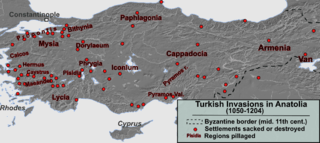
What followed the battle was a chain of events—of which the battle was the first link—that undermined the Empire in the years to come. They included intrigues for the throne, the fate of Romanos, and Roussel de Bailleul attempting to carve himself an independent kingdom in Galatia with his 3,000 Frankish, Norman, and German mercenaries.[35] He defeated the Emperor's uncle John Doukas, who had come to suppress him, advancing toward the capital to destroy Chrysopolis (Üsküdar) on the Asian coast of the Bosphorus. The Empire finally turned to the spreading Seljuks to crush de Bailleul (which they did). However the Turks ransomed him back to his wife, and it was not before the young general Alexios Komnenos pursued him that he was captured. These events all interacted to create a vacuum that the Turks filled. Their choice in establishing their capital in Nikaea (Iznik) in 1077 could possibly be explained by a desire to see if the Empire's struggles could present new opportunities.
In hindsight, both Byzantine and contemporary historians are unanimous in dating the decline of Byzantine fortunes to this battle. As Paul K. Davis writes, "Byzantine defeat severely limited the power of the Byzantines by denying them control over Anatolia, the major recruiting ground for soldiers. Henceforth, the Muslims controlled the region. The Byzantine Empire was limited to the area immediately around Constantinople, and the Byzantines were never again a serious military force."[36] It is also interpreted as one of the root causes for the later Crusades, in that the First Crusade of 1095 was originally a western response to the Byzantine emperor's call for military assistance after the loss of Anatolia.[37] From another perspective, the West saw Manzikert as a signal that Byzantium was no longer capable of being the protector of Eastern Christianity or of Christian pilgrims to the Holy Places in the Middle East. Delbrück considers the importance of the battle to be exaggerated, but the evidence makes clear that it resulted in the Empire being unable to put an effective army into the field for many years to come.[38]
The Battle of Myriokephalon, also known as the Myriocephalum, has been compared to the Battle of Manzikert as a pivotal point in the decline of the Byzantine Empire.[39] In both battles, separated by over a hundred years, an expansive Byzantine army was ambushed by a more elusive Seljuk opponent. The implications of Myriocephalum were initially limited, however, thanks to Manuel I Komnenos holding on to power. The same could not be said of Romanos, whose enemies "martyred a courageous and upright man", and as a result "the Empire ... would never recover".[35]
Cultural references
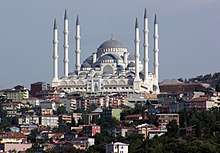
The largest mosque in Turkey, the Çamlıca Mosque of Istanbul has four minarets that span 107.1 metres, a measurement that refers to the Battle of Manzikert (1071).[40] In 2018, Turkey's ruling AKP announced their future agenda for 2023, 2053 and 2071 targets: 100th anniversary of the republic, 600th anniversary of conquest of İstanbul and 1000th anniversary of battle of Manzikert, respectively.[41] The battle also make an appearance in Age of Empires II: The Conquerors as part of Battle of the Conquerors campaign scenarios.[42]
Notes
- Pechenegs and Cumans defected to the Seljuq side when the war began.
References
- Nesbitt, John and Eric McGeer. Catalogue Of Byzantine Seals At Dumbarton Oaks And In The Fogg Museum Of Art. 1st ed. Washington, DC: N.p., 2001. Print.
- Church, Kenneth. From Dynastic Principality To Imperial District. 1st ed. 2001. Print.
- The Cambridge Medieval History, vol. 6 (Cambridge: University Press, 198), p. 791: "In 1071, five years after Hastings, the Byzantine army, the oldest and best trained military force in Europe, was destroyed in battle with the Seljuq Turks at Manzikert in Armenia."
- Steven Runciman, A History of the Crusades, vol. 1 (Cambridge: University Press, 1987), pp. 62-63: "With this large but untrustworthy army, Romanus set out in the spring of 1071 to reconquer Armenia. As he was leaving the capital the news came through from Italy that Bary, the last Byzantine possession in the peninsula, had fallen to the Normans. The chroniclers tell in tragic detail of the Emperor's march eastward along the great Byzantine military road. His intention was to capture and garrison the Armenian fortresses before the Turkish army should come up from the south. Alp Arslan was in Syria, near Aleppo, when he heard of the Byzantine advance. He realized how vital was the challenge; and he hurried northward to meet the Emperor. Romanus entered Armenia along the southern branch of the upper Euphrates. Near Manzikert he divided his forces."
- Haldon 2001, p. 173
- Markham, Paul. "Battle of Manzikert: Military Disaster or Political Failure?".CS1 maint: ref=harv (link)
- Haldon 2001, p. 172
- Haldon 2001, p. 180.
- Grant, R.G. (2005). Battle a Visual Journey Through 5000 Years of Combat. London: Dorling Kindersley. p. 77. ISBN 1-74033-593-7.
- Holt, Peter Malcolm; Lambton, Ann Katharine Swynford & Lewis, Bernard (1977). The Cambridge History of Islam. pp. 231–232.CS1 maint: ref=harv (link)
- Barber, Malcolm. The Crusader States Yale University Press. 2012. ISBN 978-0-300-11312-9. Page 9
- Norwich, John Julius (1997). A Short History of Byzantium. New York: Vintage Books. p. 240. ISBN 0-679-45088-2.
- Norwich, John Julius (1997). A Short History of Byzantium. New York: Vintage Books. p. 241. ISBN 0-679-45088-2.
- Thomas S. Asbridge The Crusades (2010) p 27
- Konstam, Angus (2004). The Crusades. London: Mercury Books. p. 40. ISBN 0-8160-4919-X.
- Norwich, John Julius (1997). A Short History of Byzantium. New York: Vintage Books. p. 236. ISBN 0-679-45088-2.
-

- J. Haldon, The Byzantine Wars, 180
- Hillenbrand 2007, p. 7-8
- Morris, Rosemary; Tucker, Spencer (2019). "Manzikert, Battle of (August 26,1071)". In Tucker, Spencer (ed.). Middle East Conflicts from Ancient Egypt to the 21st Century: An Encyclopedia and Document Collection. Santa Barbara: ABC-CLIO. p. 800. ISBN 978-1-4408-5352-4.
- Hillenbrand 2007, p. 214
- J. Norwich, Byzantium: The Apogee, 238
- Konstam, Angus (2004). The Crusades. London: Mercury Books. p. 41. ISBN 0-8160-4919-X.
- Norwich, John Julius (1997). A Short History of Byzantium. New York: Vintage Books. p. 239. ISBN 0-679-45088-2.
- Heath, Ian; McBride, Angus (1979). Byzantine Armies, 886–1118. London: Osprey. p. 27. ISBN 0-85045-306-2.
- Nicolle, David. Manzikert 1071: The breaking of Byzantium. Osprey Publishing (20 August 2013), pp. 80–81. ISBN 978-1780965031
- Peoples, R. Scott (2013) Crusade of Kings Wildside Press LLC, 2008. p. 13. ISBN 0-8095-7221-4, ISBN 978-0-8095-7221-2
- Alp Arslan, the lion of Manzikert
- Hillenbrand 2007, p. 78
- Haldon, John (2000). Byzantium at War 600–1453. New York: Osprey. p. 46. ISBN 0-415-96861-5.
- Mikaberidze, Alexander (2011). Conflict and Conquest in the Islamic World: A Historical Encyclopedia. ABC-CLIO. p. 563. ISBN 1-59884-336-2.
- Norwich, John Julius (1997). A Short History of Byzantium. New York: Vintage Books. pp. 240–3. ISBN 0-679-45088-2.. Andronikus returned to the capital, Tarchaneiotes did not take part, Bryennios and all the others, including Romanos, took part in the ensuing civil war.
- Norwich, John Julius (1997). A Short History of Byzantium. New York: Vintage Books. p. 242. ISBN 0-679-45088-2.
- "Medieval Sourcebook: Anna Comnena: The Alexiad: Book I". Archived from the original on 14 September 2008. Retrieved 26 August 2008.
- Norwich, John Julius (1997). A Short History of Byzantium. New York: Vintage Books. p. 243. ISBN 0-679-45088-2.
- Paul K. Davis, 100 Decisive Battles from Ancient Times to the Present: The World's Major Battles and How They Shaped History (Oxford: Oxford University Press, 1999), p. 118.
- Madden, Thomas (2005). Crusades The Illustrated History. Ann Arbor: University of Michigan P. pp. 35. ISBN 0-8476-9429-1.
- Delbrück, Hans (1923). "7. Kapitel: Byzanz" [Chapter 7: Byzantium]. Geschichte der Kriegskunst im Rahmen der politischen Geschichte (in German). 3. Teil: Das Mittelalter (2nd ed.). Berlin: Walter de Gruyter. pp. 209–210. Retrieved 22 April 2012.
- For example, Vryonis, Speros (1971). The Decline of Medieval Hellenism in Asia Minor: and the process of Islamization from the eleventh through the fifteenth century. Berkeley: University of California. p. 125. ISBN 0-520-01597-5.
- "Turkey's largest mosque opens its doors in Istanbul". Gulf Times. Istanbul. DPA. 8 March 2019.
- "TÜRKİYE'NİN 2023, 2053 VE 2071 HEDEFLERİ | YeniBirlik Gazetesi". www.gazetebirlik.com. Retrieved 3 September 2019.
- TheViperAOC - Age of Empires 2 (20 June 2017), Age of Empires II: The Conquerors Campaign - 4. Battle of the Conquerors - Manzikert(1071), retrieved 16 June 2020
Further reading
- Haldon, John (2001). The Byzantine Wars: Battles and Campaigns of the Byzantine Era. Stroud: Tempus. ISBN 0-7524-1795-9.CS1 maint: ref=harv (link)
- Carole Hillenbrand (2007). Turkish Myth and Muslim Symbol: The Battle of Manzikert (illustrated ed.). Edinburgh University Press. ISBN 9780748625727.CS1 maint: ref=harv (link)
- Treadgold, Warren (1997). A History of the Byzantine State and Society. Stanford: Stanford University Press. ISBN 0-8047-2421-0.CS1 maint: ref=harv (link)
- Runciman, Steven (1951). "A History of the Crusades". One. New York: Harper & Row. Cite journal requires
|journal=(help)CS1 maint: ref=harv (link) - Norwich, John Julius (1991). Byzantium: The Apogee. London: Viking. ISBN 0-670-80252-2.CS1 maint: ref=harv (link)
- Carey, Brian Todd; Allfree, Joshua B. & Cairns, John (2006). Warfare in the Medieval World. Barnsley: Pen & Sword Books. ISBN 1-84415-339-8.CS1 maint: ref=harv (link)
- Konstam, Angus (2004). Historical Atlas of The Crusades. London: Mercury. ISBN 1-904668-00-3.CS1 maint: ref=harv (link)
- Madden, Thomas (2005). Crusades The Illustrated History. Ann Arbor, MI: The University of Michigan Press. ISBN 0-472-03127-9.CS1 maint: ref=harv (link)
- Konus, Fazli (2006). Selçuklular Bibliyografyası. Konya: Çizgi Kitabevi. ISBN 975-8867-88-1.CS1 maint: ref=harv (link)
External links
- Battle of Manzikert: Military Disaster or Political Failure?, by Paul Markham
- Debacle at Manzikert, 1071: Prelude to the Crusades, by Brian T. Carey (Issue 5 – January 2004)
- Lady for Ransom (1953), a historical novel by Alfred Duggan featuring the Battle of Manzikert.